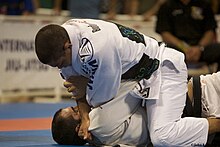Mount (martial arts)
The mount is a basic position in martial arts . The dominant fighter "sits" on the opponent's chest.
This technique is mainly used in grappling martial arts such as Luta Livre , Sambo , Brazilian Jiu-Jitsu , or mixed martial arts .
The upper fighter can use levers (such as the triangle choke , armbar or a kimura ). In MMA, the rules also allow blows to the head with the fists or elbows while the fighter lying below has to defend.
The top priority for the "lower" fighter is to escape from the mount and change to a better position, such as the guard or a sweep , ie "throwing" the opponent.
Different variants of the mount
Low mount
If the fighter sits relatively low, it is called a low mount. This brings a higher stability with it, since the legs of the opponent can be secured / blocked. The disadvantages are that the dominant must first “work” its way up towards the chest in order to attack effectively.
High mount
If a fighter "mounts" the opponent so high that he is with his knees under his armpits, one speaks of a "high mount". In this position it is relatively easy to roll the attacker to the side (sweep) if he does not have sufficient stability. However, according to the disadvantages of the low-mount position, it can attack more easily here.
However, it can be thrown using "Bridge and Roll", a technique comparable to that of a rodeo. To do this, the hip is raised, the aim of which is to make the opponent unstable. As a result, it can be rolled over its own longitudinal axis, i.e. H. Be "swept". The higher the opponent mounts, the less effective the technique, since the opponent's center of gravity is on the chest (and thus away from the hips).
If the position is too high, it may be possible to escape by moving forward under the legs, so that the fighter on the ground can now go on the offensive himself and, for example, attack the opponent's back.
S-mount
The S-Mount is a special feature. One leg is placed under the opponent's neck while the other is used to block the torso between the armpit and the hip. So the legs are a bit like an "S".
A trained fighter thus achieves greater stability, as he can compensate for movements of the person lying on the ground. He can also schedule further submissions from this position, e.g. B. the triangle choke from the mount.
Submissions from the mount
The mount position is ideal for attaching a number of arm levers such as "Kimura" and "Americana", shoulder levers such as "Gogoplata" and "Omoplata" or submissions such as the "Triangle".
If the fighter tries on the ground to get the opponent down, for example by pushing or hitting (MMA), he can also use an "armbar", a lever over the elbow joint backwards.
Many are task handles (choke) from the Mount possible. Some chokes in which the GI is used as a throttling tool are basically limited to sporting events where the opponent is wearing a suit. They cannot be used in MMA or in an actual street fight unless the opponent is wearing a comparable item of clothing, such as a leather coat, a scarf or a hoodie .
defense
As mentioned above, there are a number of ways to escape the mount. A distinction must be made between "escapes", which are exclusively aimed at escaping, and "sweeps", ie changing positions by turning together with the opponent.
Escapes

Typical escapes are back door escape (moving under the opponent), bridging (also called upa escape ), in which the hips are turned up and to the side ("rodeo" drop), depending on how far up the opponent is the chest.
Another alternative is so-called shrimp , in which space is created between the legs with the hand or elbow on one side and the hip on the other, so that you can then move backwards.
The goal here is a counterattack, either to the guard or to the half guard .
Sweeps
→ Main article Sweep (martial arts)
With the help of the hip bump sweep you first get your opponent to have to support himself on the ground. The arm can then be blocked on your own body using a swimming movement so that the opponent's center of gravity is close to your own body. By blocking the foot, a lever can be created through which both opponents can roll as a unit around their own longitudinal axis.
The disadvantage of this technique is that you are still under the control of the opponent (now in the guard), from which you now have to work out further. So you are still in an unfavorable position, just in a less unfavorable position.
Under certain circumstances, however, the element of surprise can be used.
See also
- Backmount
- Side control
- Half Guard
- Guard
- Grab handle (martial arts)
- Sweep (martial arts)
- North-South position (martial arts)
- Bench (martial arts)
Web links
Individual evidence
- Gracie; Renzo, Gracie, Royler; Peligro, Kid; Danaher, John (2001). Brazilian Jiu-Jitsu: Theory and technique . Invisible Cities Press. ISBN 1-931229-08-2 .
- Løvstad, Jakob. The mixed martial arts primer . www.idi.ntnu.no . URL last accessed March 6, 2006. (DOC format)
- Page, Nicky. Groundfighting 101 ( Memento from September 22, 2005 in the Internet Archive ). homepage.ntlworld.com . URL last accessed March 4, 2006.

